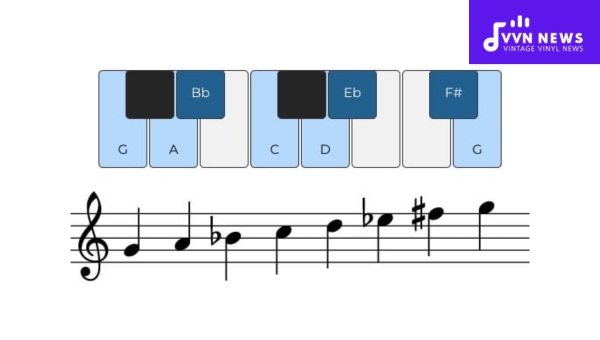As a musician seeking to broaden your skill set or a beginner starting on your musical journey, delving deeply into various scales can truly enhance your performance.
Among these scales, the G harmonic minor scale stands out with its unique sonic qualities and inherent versatility, offering numerous avenues for music makers to explore.
Having spent countless hours practicing different scales myself, I’ve always found it instrumental to dig into the heart of each one.
If you’ve ever stumbled across a composition with a subtly mysterious undertone that piqued your interest, chances are you were listening to something written in the G harmonic minor scale.
This intriguing note sequence holds an array of hidden treasures waiting for discovery, which is exactly what we’re about to dive into today.
Interval Composition of the G Harmonic Minor Scale
Exploring the interval composition of this unique scale unveils an assortment of tones and semitones.
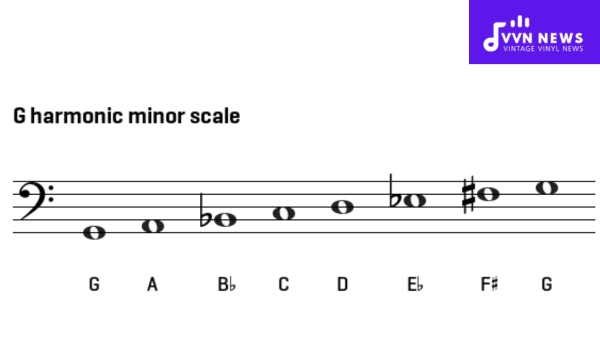
This composition offers a rich tonal palette to wield your artistic expression.
Constructed with a precise structure, the G Harmonic minor scale amplifies its unique tone through these intervals:
- G to A – Whole tone
- A to Bb – Semitone
- Bb to C – Whole tone
- C to D – Whole tone
- D to Eb – Semitone
- Eb to F# – Augmented 2nd (a gap slightly bigger than a whole tone)
- F# to G – Semitone
To truly grasp these intricacies, practicing them on your instrument both visually and audibly is essential for amplifying your musical intuition around this uniquely harmonic minor scale.
Also Read: Understanding Music Transposition: A Complete Guide
The Formula of the Harmonic Minor Scale
The harmonic minor scale is crafted with a very specific sequence of whole and half steps.
It is marked by the characteristic leap, or skip, between the sixth note which is a minor sixth, and the seventh note, a major seventh in its ascending run.
The formula can be comprehensively written as follows:
- From tonic to second: Whole step
- From second to third: Half-step
- From third to fourth: Whole step
- From fourth to fifth: Whole step
- From fifth to sixth: Half-step
- From sixth to seventh: One and a half steps or an augmented second
- Finally, from the seventh back to the tonic (the octave): Half step
This sequence of steps crafts that distinctive, almost haunting sound we typically associate with the harmonic minor scale.
Crystallizing this formula will help you as you explore creating and performing music within this scale.
Composition of the G Harmonic Minor Scale
This intriguing scale is composed of seven different degrees. In the world of music, a ‘degree’ refers to a specific position on a scale.
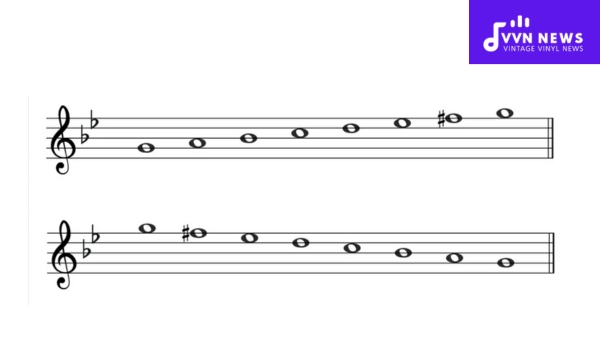
- First Degree – G: This is the root note, or tonic, of the G harmonic minor scale and acts as our starting point.
- Second Degree – A: A whole step up from G, this is known as the supertonic.
- Third Degree – Bb: This note, referred to as the mediant, introduces a flavor of minor quality into the scale.
- Fourth Degree – C: Known as the subdominant; it mainly functions to create tension or resolve it.
- Fifth Degree – D: The dominant provides tension that seeks resolution back to G when used in harmony.
- Sixth Degree – Eb: Acting as the submediant, this note further contributes to the minor character of our scale.
- Seventh Degree – F#: This note is rather special because unlike natural minor scales which have a whole step between their 7th and 1st degrees, harmonic minors like ours have an unusual jump – they go straight from Eb (the 6th) to F# (the 7th). This forms an augmented 2nd interval that gives harmonic minors their unique sound.
By delving into each degree individually, you can appreciate its role in bringing together this distinct musical composition.
And there you have it! The beautiful complexity that makes up the G Harmonic Minor Scale!
Also Read: Harmony In Music [Enhance Your Compositions With These Tips]
Exploring the Modes of G Harmonic Minor
When venturing into the incredible diversity of the G Harmonic Minor scale, one fascinating aspect to explore is its derived modes.
These modes provide unique sonic landscapes while maintaining the scale’s enchanting and exotic character.
Aeolian #7
The first mode we’re diving into, also known as the G harmonic minor, is the Aeolian #7.
This model features a very distinctive sound due to its raised seventh note. While it primarily retains the moody feel of a minor key, the raised seventh adds an unusual twist, creating a contrasting sense of excitement and tension within compositions.
Locrian #6
The second mode, Locrian #6, has an additional sharp note compared to its natural counterpart- The sixth note.
This modification generates a tone darker than other minor modes but with a slight lift provided by the sharpened sixth.
Ionian #5
Next comes Ionian #5 or Major #5- A major mode with a raised fifth note.
It bears a resemblance to traditional major scales but features an augmented fifth (sharp five), giving it an unusually bright and vivid character that can liven up your compositions remarkably.
Altered Dorian
Altered Dorian offers an experimental deviation from the conventional Dorian mode.
The alterations featuring flat nine and sharp five transform its relaxed tonal atmosphere into something more whimsical and unpredictable.
Phrygian Dominant
Moving forward to one of the most notable offspring of this scale – Phrygian Dominant, also identified as Spanish Gypsy or Freygish scale.
Its peculiar third note provides an exotic element usually associated with Middle Eastern music, which instantly captures the listener’s attention and evokes intrigue.
Lydian#2
Next in line is Lydian#2 which brings another uncommon departure from natural modes with its raised second note. The effect is both startling and refreshingly vibrant.
Super Locrian 7
Lastly, referred to as Altered minor, Super Locrian 7 gives off an intensely variable sonic landscape due to its multiple altered factors.
Here the flat two, flat three, augmented fourth, and double flat seven give a sense of harmonic tension and musical peculiarity.
Play around with these modes arising from the G Harmonic Minor Scale, and expand your melodies’ mood or emotion articulation.
Remember that each alteration throws a surprising twist into their natural counterparts’ character.
Also Read: E Major: Scale And Chords [Exciting Sounds For Your Compositions]
How to execute G Harmonic Minor on piano and guitar?
Piano and guitar are two instrumental stalwarts that you might want to master the G harmonic minor scale on.
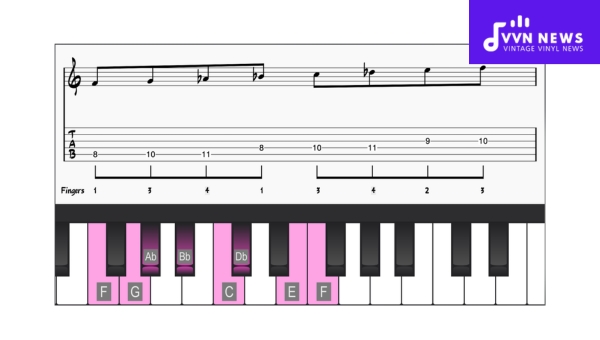
Let’s delve into the specifics of how to navigate this unique scale on both these versatile instruments.
Executing the G Harmonic Minor on Piano
Playing the G Harmonic Minor scale on the piano, involves seven distinct notes, starting with G. Let’s break down each step:
- Begin by placing your thumb (1st finger) on G.
- Continue to the next note by pressing A with your 2nd finger.
3 Understand that B flat comes next; use your 3rd finger here. - Cross your thumb (1st) under to press C.
- Utilize the 2nd, 3rd, and 4th fingers for D, E flat, and F# respectively.
6 Lastly, use your 5th finger (the pinky) to press the final note: G.
In descending order, you mirror these steps in reverse.
Playing The G Harmonic Minor on Guitar
For guitarists wanting to explore this captivating scale, you’ll utilize specific frets and string positions:
Open Position (using open strings)
Start with this pattern:
- On the Low E string (6th), play Fret 3 (G) using your middle finger.
- On A string (5th), play Fret 1 (A) with your index finger
- Use your ring finger for A string Fret 3 (Bb).
- Move down a string to D(4th) and play Fret open (C).
- Still, on D string, navigate to Fret 2 (D) via the middle finger
- Shift to high E(1st) string openly tuned to produce the desired sound(E)
Closed Position (no open strings)
Implementing a closed position allows guitarists to familiarize themselves further with fretboards
- Middle F touches Low E(6th) at Fret 3(G)
- Play Fret 5 on the same string, using your pinky finger. Here you find an important note: A.
- For Bb, shift to A string (5th) Fret 1 with your index finger
- Then, use the ring finger for A string Fret 3 denoting C
- Next string (D -4th), Plant your index finger on Fret 0, translating to D
- To land on the keynote E, Play fret 2 on the same string
By practicing these positions and patterns repetitively, You will be executing the G Harmonic Minor scale with ease in no time.
Key Signature Specifics for G Harmonic Minor
The G Harmonic Minor scale consists of the notes G, A, Bb, C, D, Eb, and F#.
There’s an interval of a half step between the second and third notes (A and Bb), the fifth and sixth notes (D and Eb), as well as the seventh note (F#) and octave (G).
Unlike its natural minor counterpart which contains a whole step between the 7th & 8th degrees, it features a raised seventh degree which leads to an interval of three half-steps (a minor third) between the 6th and 7th degrees, creating its distinct harmonic ‘skip’. This unique element gives this scale an exotic flair.
Also Read: A Sharp Minor Pentatonic Scale [Unique Harmonic Possibilities]
Representations of G Harmonic Minor in Various Clefs
The visual representation or notation of the G Harmonic Minor scale through varying clefs offers a comprehensive illustration that helps illuminate musical structures for musicians of all varieties: pianists, violinists, and trombonists, among others.
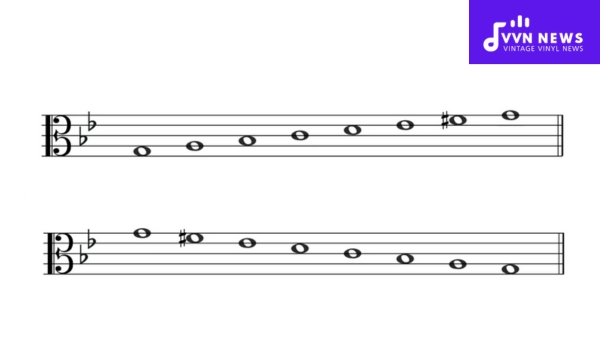
As musical knowledge diversifies across instruments, it becomes increasingly necessary to familiarize yourself with the different faces this scale can take on.
Treble Clef Representation
The G Harmonic Minor scale in the treble clef incorporates one sharp. This annotation commences on G, continues up to A, followed by B flat.
We then experience a natural progression to C and D before we reach E flat, and finally resort to an F# before landing back on G.
The visual construction is relatively straightforward once you get the hang of it.
By knowing how the sharps and flats align on your stave, you’ll be rendering harmonic minor scales in no time!
Bass Clef Representation
Down in the lower sonic registers, we find our scale represented within the bass cle Understandably, this can appear a bit different due to positional disparities.
Similarly, our scale begins at G and ascends to A before hitting a B flat; from here, it progresses naturally onto C and D.
We then encounter an E flat and finish strong with F# and our octave root note of G.
Alto Clef & Tenor Clef Representations
For musicians harnessing violas or trombones who transcribe within alto or tenor clefs respectively – don’t feel excluded!
The same pattern applies wholly; all we do is adjust note positions according to each specific clef context.
A commonality among all formats is their unified adherence to assigning one sharp (F#), indicating that they are part of G harmonic minor scale territory where notes display distinguishing characteristics for composition creativity.
Sharps and flats pivotally impact where notes occur visually on your music sheet relative to the chosen clef. They reflect variant pitches transposed across multiple octaves.
Also Read: Mastering Chords In A Minor [Improve Your Composition Skills]
Chord Formation within the G Harmonic Minor Scale
When turning our attention to chords, the G harmonic minor scale paves the way for a host of possibilities, granting tonal flexibility that can breathe life into any composition.
In essence, there are seven primary chords applicable to this scale:
- G minor (G – Bb – D)
- A diminished (A – C – Eb)
- Bb augmented (Bb – D – Gb)
- C minor (C – Eb – G)
- D major (D – F# – A)
- Eb major (Eb – G – Bb)
- F# diminished (F# – A- C)
Each chord holds its characteristic sound within this flavorful scale, so I encourage you to experiment freely with these musical building blocks in various combinations and patterns!
FAQs
What makes the G Harmonic Minor scale unique?
The G Harmonic Minor scale is unique due to its raised seventh note, which gives it an “Eastern” or “exotic” sound, broadening your palette of musical expression.
How many sharps or flats does the G Harmonic Minor have?
The G Harmonic Minor scale includes two flats – B flat and E flat.
What are some common chords in the G Harmonic Minor scale?
Common chords within this scale are G minor, A diminished, B flat augmented, C minor, D minor, E flat Major, and F# diminished.
Can I use the G Harmonic Minor in any style of music?
Yes, definitely! The G harmonic minor can be used across various styles – from classical music to jazz to pop – offering a captivating and distinctively different flavor.
Where can I find example songs composed in the G harmonic minor scale?
There are umpteen compositions in this scale across varied genres. Bach’s “Toccata and Fugue in D Minor” is a popular classical composition employing G harmonic minor.
Also Read: Transposition Chart [A Lifesaver For All Musicians]
Conclusion
Your exploration into the fascinating G harmonic minor scale is a splendid leap towards enriching your musical prowess. This certain minor scale offers an intoxicating blend of tones, sure to elevate your compositions.
For those grappling with chord progressions, it will provide fresh opportunities to experiment. Always remember, that music is an endless journey, and with each new scale we master, we widen our vessel of expressiveness.
Embrace the G harmonic minor, and let its unique voice broaden your musical horizons!
